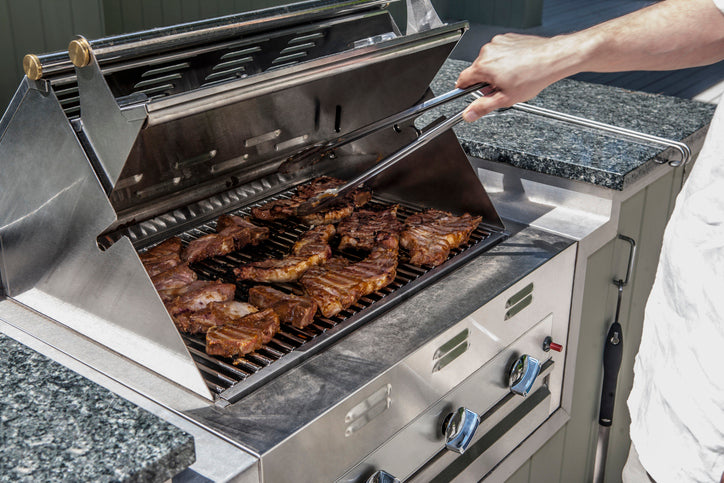When it comes to creating an outdoor BBQ station, there’s nothing better than setting up a space that’s as relaxing as it is functional.
More than ever, people are looking for a peaceful escape outdoors, and they’re also willing to spend big money on a high-end grill or smoker.
“High-end” often goes hand in hand with “big.” As the size and weight of these behemoths have shot up, a heavy-duty hinge design has become ultra-important to keeping your lid secure and long-lasting.
Now's the time to refine your grill or BBQ smoker hinge design guidelines to build a safer, more luxurious product for the consumer’s tastes.
6 Grill/BBQ Smoker Hinge Design Guidelines
A heavy-duty grill hinge should address your needs for both function and feel. When evaluating a hinge, whether it’s for a replacement or part of a new DIY smoker you’ve constructed, make sure you consider these six hinge design guidelines:
- Heat
- Design spacing
- Enclosure shape
- Cycle life
- Load-bearing requirements & motion features
- Safety
1. Environment
The design of any BBQ grill hinge should absolutely consider the toasty environment in which they’ll be living (or dying). At the least, poor materials and finishing will cause your product to flake and look ugly. At worst, the hinge could fail and injure the end user.
Appliances operating in an outdoor environment have triple the durability considerations of indoor/kitchen equipment. What makes grill door hinges or BBQ smoker hinges different is that in addition to designing around heat concerns, you’ve also got to deal with UV rays and corrosion. That’s why it’s important to look at both weather-resistant hinges and rust-resistant hinges. And given the exposure to high temperatures, it's also important to look at heat-resistant hinges.
Powder coated hinges are ideal for outdoor environments. Stainless steel is even better because it’s highly corrosion-resistant. Depending on the max temperature of your application, you may need something even more robust -- chrome or silicon alloys, or maybe even Inconel. This new family of nickel-chromium supermaterials resists oxidation and corrosion up to about 700°.
Whatever you do, don’t use gas springs — they’ll explode at high temperatures.
2. Design Spacing
Is the grill lid hinge intended to be visible outside of the appliance or hidden internally? If aesthetics are important, you’ll probably choose the latter.
In either case, you'll have to work closely with the manufacturer to determine the minimum space it needs to successfully manufacture counterbalance hinges — and for you to assemble them within the product. This can be tricky, potentially impacting the load-bearing ability or even the range of motion of the hinge.
Spacing also ties into #1 above. A component placed near the heat source will need a more durable (and expensive) material and/or finish.
3. Shape of Grill/Cooking Unit
It’s important to understand the mechanics and the physics of designing around a product — especially if there's a contoured radius or contoured edge. If a heavy-duty grill hinge doesn't a) fit correctly, and b) apply torque correctly when lifted, safety and convenience are at risk.
Kamado smokers are rounded and typically more challenging to work with than a standard rectangular grill. When you're working with rounded edges, you'll likely have to perform more calculations when working with weight-bearing hinges. Hinges have to fit around something to do their job, and torque will vary compared to a flat, box-type grill.
4. Desired Cycle Life
One of the hazards of a cheap BBQ smoker door hinge is the lack of durability and safety.
A poorly designed hinge will one day lead to an abruptly closing lid, which can damage the equipment or even injure its user. Communicate your desired cycle life up front to your hinge manufacturer. The frequency of daily use for your application (along with the budget you’re willing to spend on cycle life) will dictate your material options.
5. Load-Bearing Requirements & Motion Features
Ask 10 consumers how they want an ideal grill lid to function and chances are you'll get several different answers. Some want a soft open and/or close. Others want the lid to drop from a certain point, or stay open at a certain angle when they let go. Some want assist hinges; others want a counterbalance system.
Assist hinges make the lid feel lighter during opening and closing, while counterbalance hinges keep the lid at whatever position you let go at. A floating hinge grill makes outdoor cooking easy for anybody, regardless of height or strength.
6. Safety Concerns
Work directly with the manufacturer’s engineering team to identify safety issues (i.e., your grill lid having a history of slamming on fingers, or wind being able to easily knock it down). Whether you're making a new product line or trying to resolve liability issues with a current one, it’s on you to invest in the hinge technology your lid needs to pose no threat to users.
The more your manufacturer knows about what went wrong, or what you think could go wrong, the more easily it can guide you to a safe solution.
BBQ Smoker Hinges That Deliver
The last thing anyone wants to worry about in their personal backyard oasis is a component of it failing — or worse yet, causing injury.
As the centerpiece of an outdoor cooking area, a grill or smoker should be optimized for function. With the proper hinge type, a smoker or grill is set for a long, useful life.
(This blog was published in May of 2020 and updated in January 2022 to reflect current and new information.)

